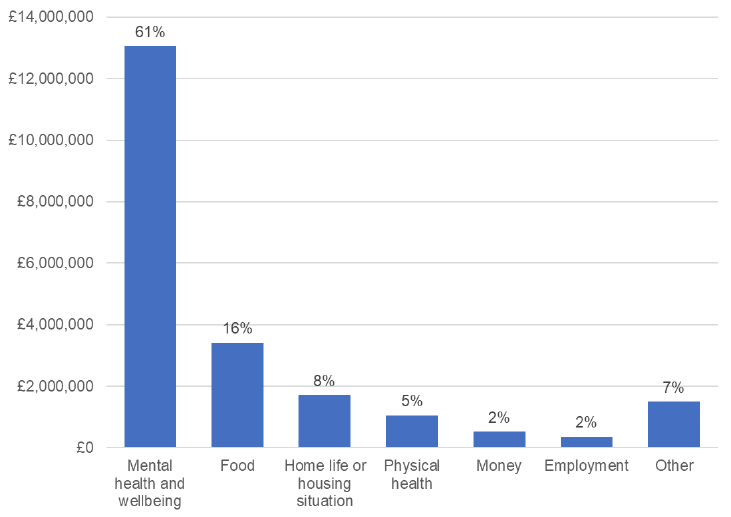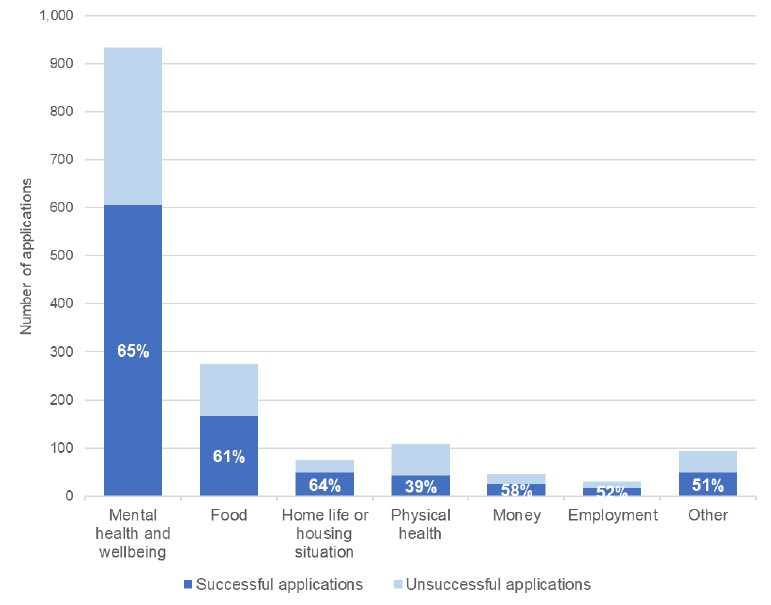Wellbeing Fund: analysis of awards
Analysis of the data on applications and awards made through the Wellbeing Fund Open Application Process and the Small Grants Fund. These funds were part of the Scottish Government’s initial 350 million overall package of funding support to communities, in response to the COVID-19 pandemic
7. Analysis by project focus
Organisations applying to the Wellbeing Fund Open Application Process indicated the thematic focus of their project, choosing one of seven categories, as follows:
| Number appli-cations | % Appli-cations | Number approved | % approved | Amount awarded | % of total value awarded | Average award size | |
|---|---|---|---|---|---|---|---|
| Employment | 31 | 2% | 16 | 52% | £349,969 | 2% | £21,873 |
| Food | 275 | 18% | 167 | 61% | £3,403,972 | 16% | £20,383 |
| Home life or housing situation | 75 | 5% | 48 | 64% | £1,709,882 | 8% | £35,623 |
| Mental health and wellbeing | 934 | 60% | 607 | 65% | £13,057,613 | 61% | £21,512 |
| Money | 45 | 3% | 26 | 58% | £515,857 | 2% | £19,841 |
| Physical health | 109 | 7% | 43 | 39% | £1,053,487 | 5% | £24,500 |
| Other | 94 | 6% | 48 | 51% | £1,491,553 | 7% | £31,074 |
Sixty percent of all applications chose 'mental health and wellbeing' as their primary activity focus area. 'Mental health and wellbeing' likewise accounted for 61% of the total amount awarded by the fund. Food was the second most frequently-chosen activity category, accounting for 18% of applications, and 16% of the funding awarded. At the other end of the scale, 'employment' and 'money' each accounted for just two percent of the value of awards.
Activity descriptions indicate substantial overlaps between categories, with many projects targeting more than one focus area. It is also noted that the application website highlighted mental health and wellbeing, and this may have led organisations to stress this aspect of their work as part of their applications.
Applications focusing on mental health and wellbeing, home life/housing situation and food had higher rates of approval, with over 60% of applications in those categories being approved. Applications focusing on physical health had the lowest approval rate at just 39%.
The average value of awards was significantly higher for projects in the 'Housing' and 'Other' categories.


Organisational responses to the challenges of the Covid-19 pandemic
In their applications, organisations demonstrated how they were developing a wide range of different approaches and activities in response to the challenges faced by their target communities.
Mental Health
Organisations undertaking projects focusing on mental health included organisations with a primary focus on mental health, and organisations which work on other issues but which had identified new/emerging mental health challenges among the groups that they usually work with.
Typical activities included moving existing services online and/or creating new online services, such as:
- One-to-one mental health coaching and counselling;
- Peer support and social events;
- Information and resources about local services, particular mental health issues relating to Covid 19, and Scottish Government updates;
- Developing bespoke mental health support programmes to cater to the current crisis;
- Befriending services;
- Workshops and classes;
- Connecting with vulnerable children via online games and platforms, and online pen-pals.
Providing practical assistance to service-users including:
- Delivering food and medication, helping with paperwork, providing toys, games and learning equipment for children and young people where needed;
- Calling service-users more regularly to check in, chat, and ask if they need anything;
- Supplying digital devices to clients so they can continue their services online and to help clients stay in touch with friends and family and access online entertainment.
Food
A wide range of organisations were seeking funding to be able to provide food to vulnerable groups, including charities for whom this has always been their primary function, as well as organisations which have switched to food provision in order to respond to people's needs since the Covid-19 crisis began.
The activities primarily reported included:
- Providing emergency food aid for people in food poverty via cooked meals and/or food parcels;
- Providing stationery and toiletries, and delivering prescriptions, alongside food;
- Using currently-closed cafes to cook hot meals for distribution to those in need;
- Many of these organisations have also set up telephone check-in services, befriending services, and/or regular telephone catch ups with those who might be feeling socially isolated.
A number of organisations that were already providing food before the lockdown noted that demand for their services had increased considerably since March 2020.
Physical Health
Services falling into this category included organisations focusing on people with specific health problems/long term illnesses etc; local gyms, sports clubs and community halls/centres; charities providing healthcare; charities linked to hospitals; and fitness organisations targeting specific groups (e.g. disadvantaged young people). Most organisations had significantly changed their activities to respond to Covid-19. For example by providing services to:
- Collect and deliver medications to their members;
- Provide meals, food vouchers, mobile and energy top ups, groceries and technology;
- Provide live and recorded online gym/exercise classes, and exercise cards (many of which are tailored to the specific health needs of the client-group);
- Provide clients with exercise equipment necessary to stay fit at home;
- Provide support for mental wellbeing including telephone support, online social sessions, online befriending, online peer support and online mindfulness;
- Some organisations were also working to convert their large buildings (e.g. community halls) into other facilities such as temporary hospitals or fitness halls.
Home life/housing
A wide range of services were included in this category, including (but not limited to) support for: children with disabilities and their families; women at risk of intimate partner violence; homeless people and those at risk of homelessness; and a range of financially vulnerable groups who might struggle to afford rent, food and utilities. Activities included:
- Providing advice, support and signposting to vulnerable people and families;
- Helping vulnerable groups with grants/vouchers to pay for food and utilities;
- Moving usual support services online/telephone;
- Regularly checking-in on vulnerable families to offer support;
- Running online group sessions for children and respite sessions for their parents;
- Offering services that are usually paid-for free of charge for vulnerable families – e.g. supplying second-hand white goods to clients and home repair work;
- Helping vulnerable groups afford utility bills, phone calls, and food via provision of emergency credit, food parcels, electricity top-ups, and phone top-ups;
- Provision of goods to help children stay entertained and access education (e.g. art and craft kits, lego, art kits, access to internet (dongles and tablets).
Money
Organisations which were already providing some form of money advice/support service sought to scale up existing services such as:
- Providing financial advice;
- Providing emergency financial assistance to specific groups in need via cash, vouchers, phone top-ups etc;
- Support with Universal Credit and benefit applications;
- Moving support activities online/onto a remote basis.
Employment
Organisations which were already providing employment support sought funding to support the following types of activities:
- Ensuring that that young people have the correct IT equipment to engage with learning and employability programmes and activities during lockdown;
- Delivery of learning/employability programmes online, including developing new online content and conducting face-to-face online contact/teaching/mentoring.
Contact
Email: socialresearch@gov.scot
There is a problem
Thanks for your feedback